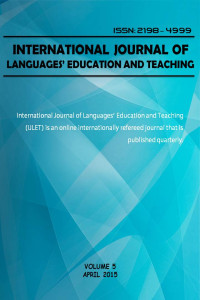Öz
Kaynakça
- Ohler, J. (2005). The world of digital storytelling.Educational Leadership, 63(4), 44–47. Otlowski, M. (1998). The writing process and CALL: Hypermedia software for developing awareness of structure in writing. Computer Assisted Language Learning, 11(4), 419-425. doi: http://dx.doi.org/10.1076/call.11.4.419.5673 Raymond, S. (2008). Digital storytelling in the classroom. Computers and Composition, 25, 449–452. doi:10.1016/j.compcom.2008.04.010
- Robin, B. R. (2008). Digital Storytelling: A powerful technology tool for the 21st century classroom. Theory into Practice, 47, 220–228.doi:10.1080/00405840802153916 Sadik, A. (2008). Digital Storytelling: A meaningful technology-integrated approach for engaged student learning. Educational Technology Research and Development, 56(4), 487–506.doi:10.1007/s11423-008-9091-8
Öz
By the help of innovative teaching practices, practitioners of education try to effectively amalgamate innovative media technologies into students` learning processes and activities. The best practices can be found in the cases where traditional ways of teaching and new media available are blended by transforming pedagogy and enabling productive ways for students to express themselves. In this respect, English as a Foreign Language (EFL) Teaching is no exception and, over the last few years, digital storytelling has entered into the agenda of language teaching practitioners as a powerful teaching and learning tool that enables both teachers and students to communicate in a digitally rich environment. Throughout the paper it is argued that digital storytelling has the potential of reaching far beyond the field of communication and that digital storytelling can be exploited as a versatile device to enable students to dwell on their creativity by making them involved in a digitally rich environment. The present paper also reports the findings of a qualitative study designed to explore how students weave fictional stories into a media enriched environment, and how the use of particular software sparks the creative writing among EFL students. The findings through archival documents and semi-structured interviews revealed that the use of digital storytelling is very likely to improve the EFL students’ writing skills.
Anahtar Kelimeler
Digital storytelling CALL in EFL context writing skill improvement
Kaynakça
- Ohler, J. (2005). The world of digital storytelling.Educational Leadership, 63(4), 44–47. Otlowski, M. (1998). The writing process and CALL: Hypermedia software for developing awareness of structure in writing. Computer Assisted Language Learning, 11(4), 419-425. doi: http://dx.doi.org/10.1076/call.11.4.419.5673 Raymond, S. (2008). Digital storytelling in the classroom. Computers and Composition, 25, 449–452. doi:10.1016/j.compcom.2008.04.010
- Robin, B. R. (2008). Digital Storytelling: A powerful technology tool for the 21st century classroom. Theory into Practice, 47, 220–228.doi:10.1080/00405840802153916 Sadik, A. (2008). Digital Storytelling: A meaningful technology-integrated approach for engaged student learning. Educational Technology Research and Development, 56(4), 487–506.doi:10.1007/s11423-008-9091-8
Ayrıntılar
| Birincil Dil | İngilizce |
|---|---|
| Konular | Dil Çalışmaları (Diğer) |
| Bölüm | Araştırma Makalesi |
| Yazarlar | |
| Yayımlanma Tarihi | 30 Nisan 2015 |
| Yayımlandığı Sayı | Yıl 2015 Cilt: 3 Sayı: 1 |


